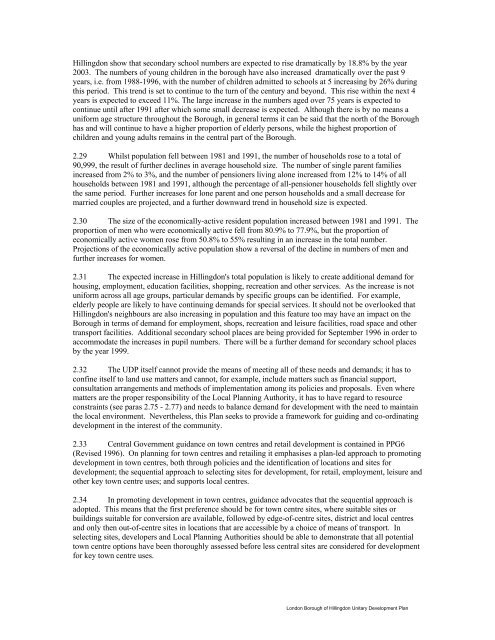HILLINGDON UNITARY DEVELOPMENT PLAN - London Borough ...
HILLINGDON UNITARY DEVELOPMENT PLAN - London Borough ...
HILLINGDON UNITARY DEVELOPMENT PLAN - London Borough ...
Create successful ePaper yourself
Turn your PDF publications into a flip-book with our unique Google optimized e-Paper software.
Hillingdon show that secondary school numbers are expected to rise dramatically by 18.8% by the year<br />
2003. The numbers of young children in the borough have also increased dramatically over the past 9<br />
years, i.e. from 1988-1996, with the number of children admitted to schools at 5 increasing by 26% during<br />
this period. This trend is set to continue to the turn of the century and beyond. This rise within the next 4<br />
years is expected to exceed 11%. The large increase in the numbers aged over 75 years is expected to<br />
continue until after 1991 after which some small decrease is expected. Although there is by no means a<br />
uniform age structure throughout the <strong>Borough</strong>, in general terms it can be said that the north of the <strong>Borough</strong><br />
has and will continue to have a higher proportion of elderly persons, while the highest proportion of<br />
children and young adults remains in the central part of the <strong>Borough</strong>.<br />
2.29 Whilst population fell between 1981 and 1991, the number of households rose to a total of<br />
90,999, the result of further declines in average household size. The number of single parent families<br />
increased from 2% to 3%, and the number of pensioners living alone increased from 12% to 14% of all<br />
households between 1981 and 1991, although the percentage of all-pensioner households fell slightly over<br />
the same period. Further increases for lone parent and one person households and a small decrease for<br />
married couples are projected, and a further downward trend in household size is expected.<br />
2.30 The size of the economically-active resident population increased between 1981 and 1991. The<br />
proportion of men who were economically active fell from 80.9% to 77.9%, but the proportion of<br />
economically active women rose from 50.8% to 55% resulting in an increase in the total number.<br />
Projections of the economically active population show a reversal of the decline in numbers of men and<br />
further increases for women.<br />
2.31 The expected increase in Hillingdon's total population is likely to create additional demand for<br />
housing, employment, education facilities, shopping, recreation and other services. As the increase is not<br />
uniform across all age groups, particular demands by specific groups can be identified. For example,<br />
elderly people are likely to have continuing demands for special services. It should not be overlooked that<br />
Hillingdon's neighbours are also increasing in population and this feature too may have an impact on the<br />
<strong>Borough</strong> in terms of demand for employment, shops, recreation and leisure facilities, road space and other<br />
transport facilities. Additional secondary school places are being provided for September 1996 in order to<br />
accommodate the increases in pupil numbers. There will be a further demand for secondary school places<br />
by the year 1999.<br />
2.32 The UDP itself cannot provide the means of meeting all of these needs and demands; it has to<br />
confine itself to land use matters and cannot, for example, include matters such as financial support,<br />
consultation arrangements and methods of implementation among its policies and proposals. Even where<br />
matters are the proper responsibility of the Local Planning Authority, it has to have regard to resource<br />
constraints (see paras 2.75 - 2.77) and needs to balance demand for development with the need to maintain<br />
the local environment. Nevertheless, this Plan seeks to provide a framework for guiding and co-ordinating<br />
development in the interest of the community.<br />
2.33 Central Government guidance on town centres and retail development is contained in PPG6<br />
(Revised 1996). On planning for town centres and retailing it emphasises a plan-led approach to promoting<br />
development in town centres, both through policies and the identification of locations and sites for<br />
development; the sequential approach to selecting sites for development, for retail, employment, leisure and<br />
other key town centre uses; and supports local centres.<br />
2.34 In promoting development in town centres, guidance advocates that the sequential approach is<br />
adopted. This means that the first preference should be for town centre sites, where suitable sites or<br />
buildings suitable for conversion are available, followed by edge-of-centre sites, district and local centres<br />
and only then out-of-centre sites in locations that are accessible by a choice of means of transport. In<br />
selecting sites, developers and Local Planning Authorities should be able to demonstrate that all potential<br />
town centre options have been thoroughly assessed before less central sites are considered for development<br />
for key town centre uses.<br />
<strong>London</strong> <strong>Borough</strong> of Hillingdon Unitary Development Plan
















